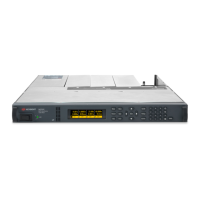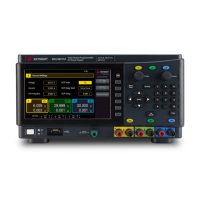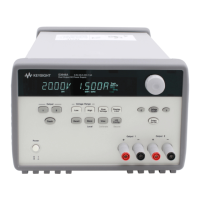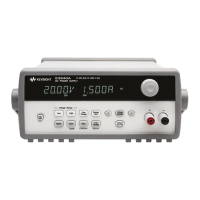Max slew rate ( V⁄s) = (Current limit setting (A) – Load current (A))/(Load capacitance (F))
The current slew rate determines the rate at which the current changes to a new programmed setting.
This applies to both current settings in current priority mode, and current limit settings in voltage
priority mode. When set to MAXimum, INFinity, or to a very large value, the slew rate will be limited by
the analog performance of the output circuit.
Front Panel Menu Reference SCPI Command
Select Output\Advanced\Slew
Then selectVoltage or Current
Enter the voltage or current slewrate in the SlewRate
field.
Check Max slewrate to program the fastest slewrate.
To setthe voltage slewrate to 5 V/s
VOLT:SLEW 5
To setthe current slewrate to 1 A/s
CURR:SLEW 1
To setthe fastest slew rate:
VOLT:SLEW MAX
Set the Output Bandwidth
Voltage bandwidth modes allow you to optimize output response time with capacitive loads.
1 (High) bandwidth mode provides maximum up-programming speed as well as the fastest transient
response settling time. This mode is optimized for use with resistive loads; however capacitive loads
up to the limits outlined in the following table can be used when using load leads shorter than 3
meters (10 feet). Exceeding these limits can lead to voltage programming overshoots and transient
response instability.
0 (Low) bandwidth mode is optimized for use with large capacitive loads up to the limits shown in the
table below, along with load leads longer than 3 meters (10 feet). In this mode the up- and down-
programming speed and voltage control-loop bandwidth are limited to prevent voltage programming
overshoots and improve transient response stability. Low mode provides the best stability and
overshoot minimization over all load configurations.
Connecting very low ESR capacitors larger than the High mode limit with load leads
shorter than 3 m (10 ft.) is not recommended in either bandwidth range. This load
configuration can lead to voltage programming overshoots.
<frequency> specifies the low-pass corner frequency of a filter applied to the programming signal. The
programmed voltage is a digitized signal which passes through a single-pole low pass filter where the
pole is specified in Hertz. This filter has the effect of slowing down the output with respect to changes
in the programmed voltage or current. This, in combination with the configurable slew setting, allows
for a trade-off between programming speed and output voltage or current overshoot. For example,
increasing the filter frequency may result in more overshoot and decreasing the frequency will lower
the overshoot, depending on the compensation setting and the load impedance. This frequency
setting does not affect the unit’s transient response to a load change.
Low-pass corner frequency programming is only available on units with firmware
revisions A.02.01.1256 and B.02.01.1256 and up. See Firmware Update.
4 Using the Advanced Power System
108 Keysight N6900/N7900 Series Operating and Service Guide
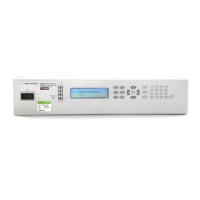
